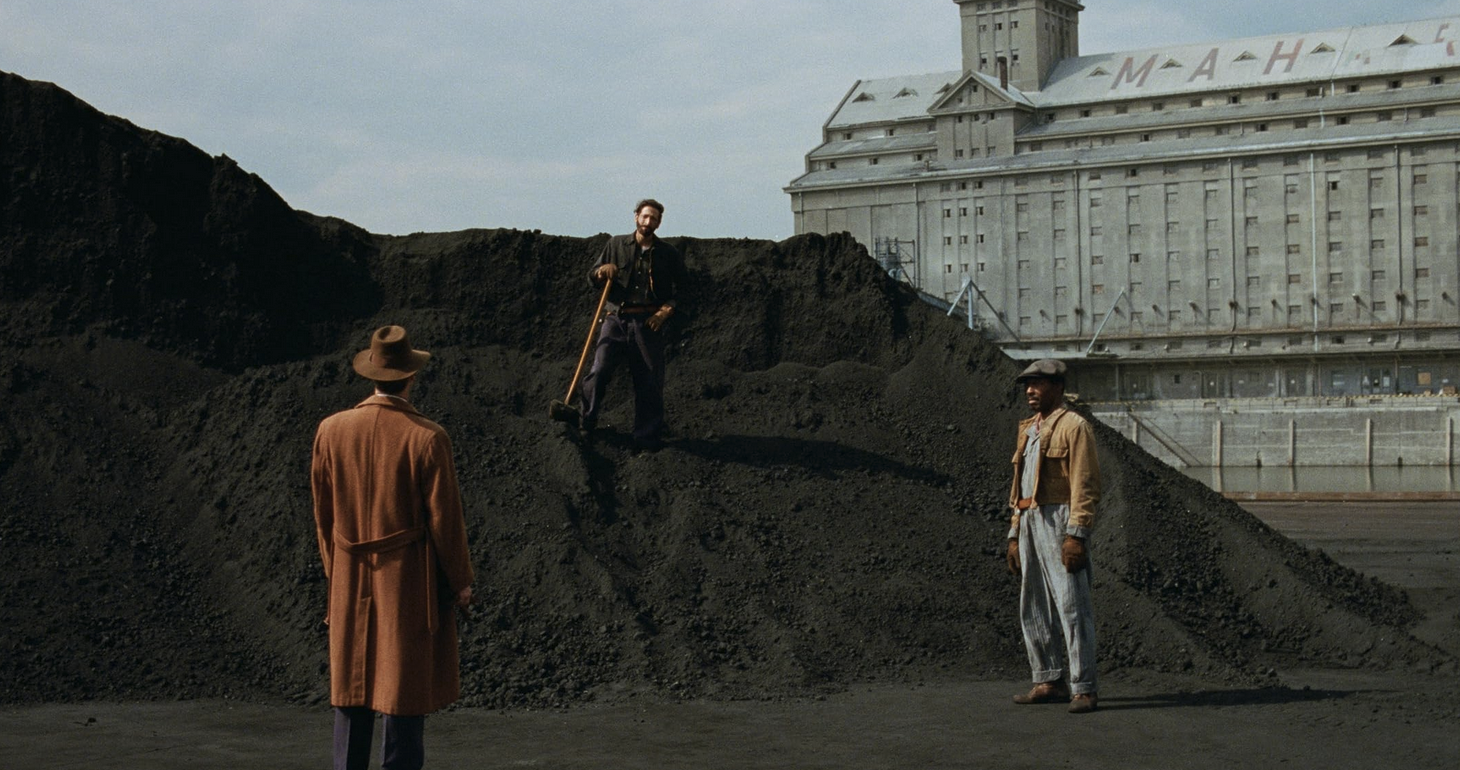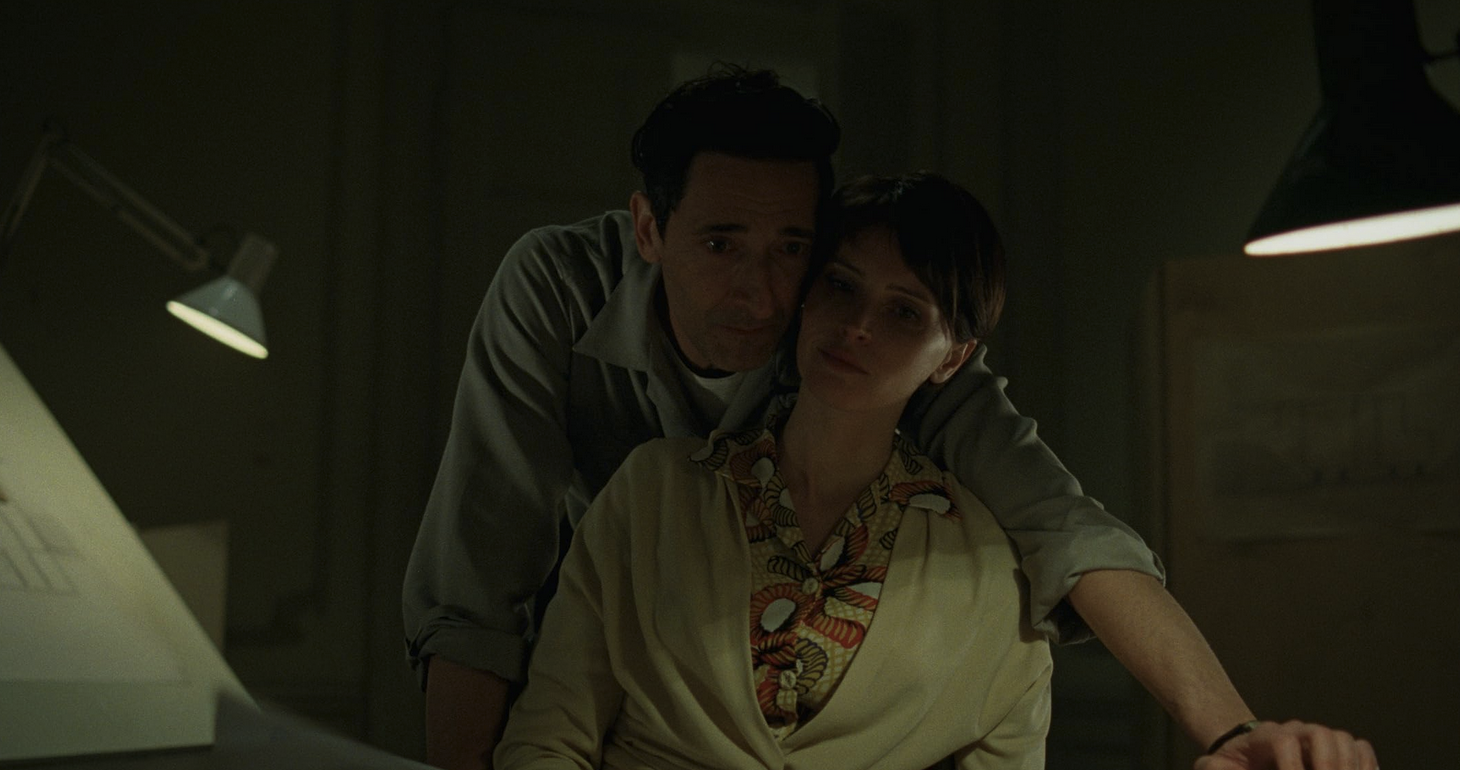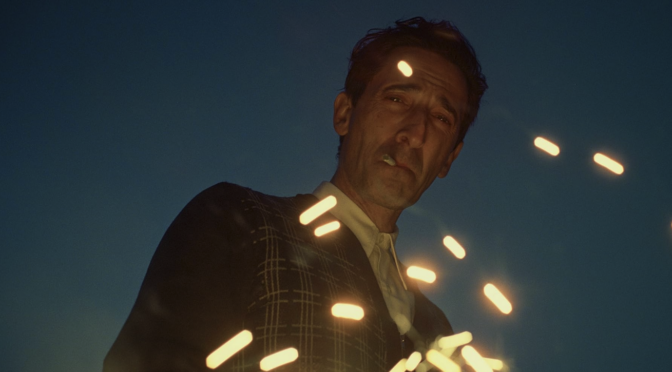The cinematic construction of THE BRUTALIST is long and complex, but Brady Corbet’s film bears the heavy load with standout aesthetics, characters, performances and script.
After a brief but thematically important prologue in which a young girl is interrogated about her ‘true home’, Adrien Brody leads as László Toth, a Holocaust survivor and architect relocating to the USA in the 1940s. Left behind in Europe are his wife, Erzsébet (Felicity Jones), and niece, Zsófia (Raffy Cassidy), the girl seen in the opening prologue. After initially staying with a cousin, Attila (Alessandro Nivola), László eventually finds his way to working on a large-scale project for a wealthy industrialist, Harrison Van Buren (Guy Pearce), with the film following the course of this project and chapter of Laszlo’s life.
Arriving with László in New York, the Statue of Liberty looms into the frame upside down, a symbolically potent (if unsubtle) abstract for the tale to follow. The film’s narrative is thematically dense despite running to over three and a half hours; it covers tolerance of immigrants in the context of American capitalism, the notion of what home truly means and whether it can be found in artistic expression.
The nucleation point for all of these ideas (even if other characters further them) is the relationship between László and Van Buren. Van Buren admires (and is perhaps envious of) László’s talent and bankrolls the project to complete a community centre dedicated to the industrialist’s mother. László is afforded an outlet for his talent but under the control of Van Buren. At every turn, László is undermined, and his voice metaphorically or literally spoken over. He has income, but no independence; agency, but not control; safety, but little dignity. Even when he is not in direct employment, a heroin addiction renders him dependent nonetheless.

“…László is undermined, and his voice metaphorically or literally spoken over. He has income, but no independence; agency, but not control; safety, but little dignity. Even when he is not in direct employment, a heroin addiction renders him dependent nonetheless.”
László is either continually swimming against the current of the society he has been forced to inhabit or justifying his existence within it. In this regard, it feels notable that the most ‘accepted’ immigrant is his cousin Attila, a handsome man with a polished American accent and a business with the false moniker of Miller & Sons. Indeed, László only makes progress on successfully bringing Erzsébet and Zsófia across after he makes the right connections in the company of Van Buren’s well-to-do inner circle.
Coupling this with the prominent backdrop of the establishment of Israel conveyed in radio broadcasts also feels like a further layer of pain. Displacement and suffering – such as that experienced by László and his family – begets displacement and suffering. The film doesn’t offer answers to some of these questions, but to hear the emotionally weary Zsófia justify her pursuit of ‘aliyah’ (emigration of Jewish diaspora to Israel) invites questions about the roles of Western capitalism, immigration tolerance, and American anti-semitism specifically (“You know, we know somebody, who can take a look at your nose”) in the rise of Zionism.
Within this dense and intersectional collection of themes comes a script that cannot help but drip with meaning in every exchange of dialogue and character dynamic. The most prominent is the artist-benefactor relationship that dominates the first half. However, amidst the testosterone, it would be easy to overlook the role of Felicity Jones’ Erzsébet. Erzsébet is an educated woman who is belittled and underestimated even more than her husband. She is regarded as the quaint ‘woman behind the man’ by the Van Burens upon her arrival. The extent of the superiority complex is laid bare as Harrison, a man who must puff himself up by announcing conversations he partakes in as “intellectually stimulating”, sets tests for her in an otherwise banal conversation in his car.
THE BRUTALIST provides a dizzying concoction of ideas, but the strands around patronising immigrants (in a manner that embraces the double meaning) and artistic expression are the most prominent on the film’s facade. The construction of the Van Buren community centre is a potent metaphor for László’s pursuit of the American Dream; an unreachable ideal, ever-promised but constantly compromised by interference and ultimately beholden to the whims of the ruling class. László articulates what architecture means to him, saying his buildings back in Europe were “not only […] new, but […] part the new whole” – they offer the opportunity to cement his place in a way he himself never will be as a foreigner.

“The construction of the Van Buren community centre is a potent metaphor for László’s pursuit of the American Dream; an unreachable ideal, ever-promised but constantly compromised by interference and ultimately beholden to the whims of the ruling class.”
Amidst all this emotional grit, the film concocts some phenomenal cinematic images, such as when László’s Italian stonemason acquaintance, Orazio (Salvatore Sansone), pours water over a block of Carrara marble. It’s a simple moment but one that conveys the beauty that Van Buren – who goes on to paw at the stone – corrupts in his pursuit of it.
The film will stand the test of time, both in terms of the ideas and questions it raises, as well as a beautiful example of the moving image. However, something about THE BRUTALIST arriving now lends the film potency. On the backdrop of a presidential election that has worrying parallels with the rise of European fascism, which unquestionably contained explicitly rabid xenophobia and fascist rhetoric, an immigrant tale of this sort inevitably has more resonance. In an environment where said President has called for buildings to “respect regional, traditional, and classical architectural heritage in order to uplift and beautify public spaces and ennoble the United States”, such a film centred on a modernist architect’s struggle to be heard – either in voice or bricks and mortar – carries another level of significance.
Such a steadfast position on current affairs is one the film is likely uninterested in taking, but in positing “it is the destination, not the journey”, as Zsófia does, it nevertheless encourages us to consider how that journey might be minimised and cast aside. An important but more glossed-over line escapes Van Buren’s lips when he says he has “offered [Laslzlo] nothing but kindness”. László may have been offered kindness, but THE BRUTALIST shows that what he received from Van Buren and the false salvation of America was far more callous.

